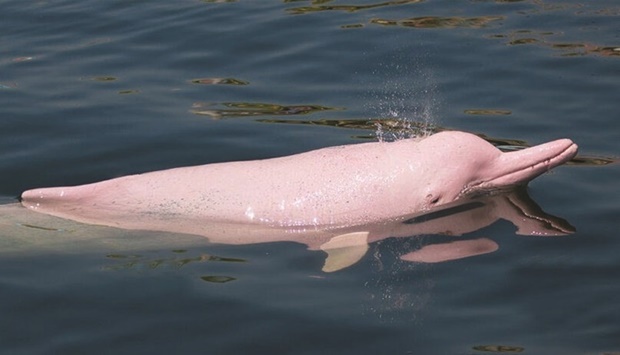One of the most wonderful river creatures that can be visually admired in the eastern region of Peru, due to its elegance, colour, grace, versatility, and intelligence, coupled with its friendly approach to human beings, is the Pink Dolphin known in Spanish as Boto, Bufeo colorado.
Nature scholars have determined that this river dolphin, the largest freshwater cetacean, has proven animal intelligence and has been scientifically identified as the “Inia geoffrensis”.
On the other hand, it is an endangered species, as its population has decreased very rapidly in recent decades.
The growing presence of human beings in the Amazon region has affected the peaceful life of this beautiful cetacean, especially due to mining activities (gold), lumber, excessive fishing as well as the intense river traffic and the noise produced by ships.
They have lived for many centuries in the Amazonian rivers and their tributaries, feeding on different species of fish, as well as small turtles and crabs; therefore, it is a carnivorous being, with a life span between 10 to 26 years.
As far as food is concerned, Pink Dolphin have similar strategies as their marine cousins by surrounding the group of fish that pass through the Amazon River in certain seasons.
Being very versatile due to the characteristics of their bone structure, they can turn their heads up to 180 degrees.
Theories that study the dolphin agree that the pink colour is the result of adaptation to the river or the capillaries of their skin or the temperature of the waters or when they are in a situation of danger, and over the years of life this colour intensifies to pink colour.
In addition, the gray colour predominates in their early ages and in females, most strikingly that males are pink since it is the male where the pigmentation pink colour is on.
River dolphins’ longer snout coupled with more pointed teeth comes to allow them to root through river mud for better feeding and echolocation allows them to navigate and find prey in the dark.
They have powerful flippers and tail flukes and they are different than marine dolphins as they have a hump in place of a dorsal fin.
They are very friendly around humans. They swim up to 30km per day and do so slowly in search of food.
The males have a size of 2.55 metres, with a weight of 207kg, and the females of 2.18 metres, with 154kg. Their gestation period is 9 to 12 months. The young are born long in the months of May to July, with a wingspan of 75cm and a weight of one kilogram, and their lactation is more than a year.
It is typically a solitary animal, seen in a maximum of three individuals. Active 24 hours a day, it can swim up to 14km per hour.
They live in harmony with other river species in the Amazon region, such as river otters.
This dolphin can also be found in the Orinoco River and the Madeira River, witnessed in the river basins that bathe the countries of Brazil, Colombia, Ecuador, Guyana, Venezuela, and Bolivia.
They are not known to be related to oceanic dolphins, from which they separated 15mn years ago in the Miocene period.
It is also worth mentioning that they breathe every 30 or 110 seconds and have a dorsal hole through which they expel water.
You may have the unique chance to swim with them or near these lovely creatures when you visit Peru, as I clearly remember these beautiful dolphins from my childhood when I lived with my family in the city located in the oriental region of Peru “Iquitos”, department of Loreto. Let’s take a moment to appreciate and admire the beauty of not only this unique creature but the beauty of what nature has given to us.

Pink Dolphin known in Spanish as Boto, Bufeo colorado.


